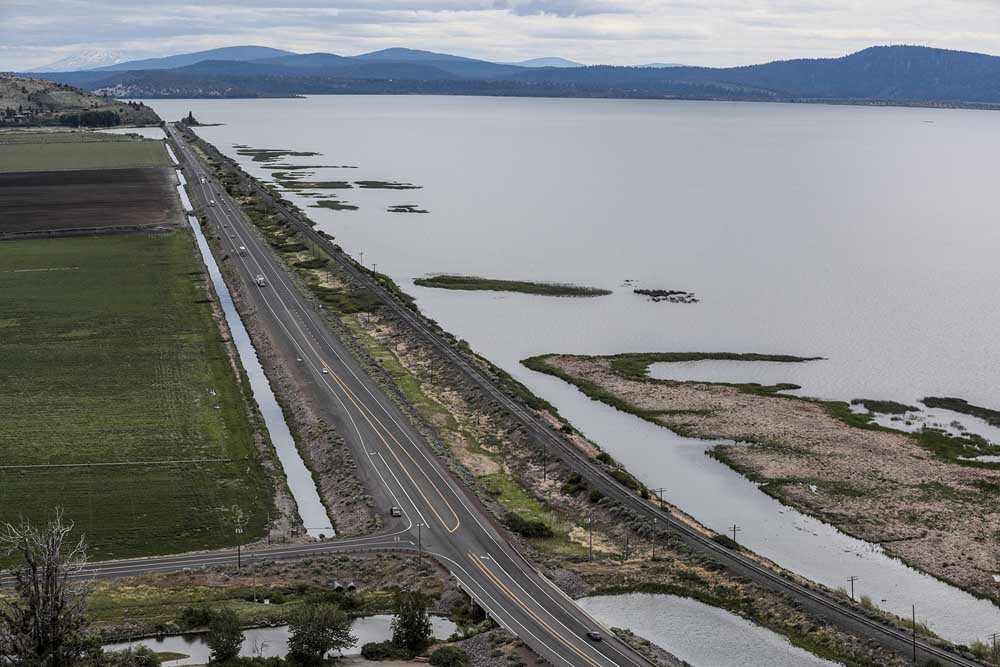Reclamation backtracks, will not curtail water to Klamath Project
Published 5:30 pm Wednesday, September 6, 2023

- U.S. Highway 97 separates farmland from the Upper Klamath Lake in Oregon in this June 2021 photo. The Bureau of Reclamation has told farmers it will not be cutting off irrigation water as it expected earlier in the year.
KLAMATH FALLS — The U.S. Bureau of Reclamation will not curtail water to the Klamath Project in Southern Oregon and Northern California, despite an earlier warning to irrigators that cutbacks might be necessary to satisfy protections for endangered fish.
The bureau initially said in May it would provide 260,000 acre-feet of water to the project from Upper Klamath Lake. On Aug. 18, Alan Heck, acting area director for the Bureau of Reclamation, sent a letter to tribes and irrigation districts notifying them of a projected shortfall in water to the project, which serves 230,000 acres of irrigated farmland.
The situation was “likely” to require an early shutdown of the project, Heck wrote. Farmers and ranchers worried the timing was likely to result in millions of dollars in damage to row crops, including potatoes, onions and garlic.
No reductions
Instead, the bureau announced Tuesday, on Sept. 5, that the project allocation will remain at 260,000 acre-feet with no reductions to irrigators.
The reversal is “due to improved hydrology in the Klamath Basin over the last two weeks; opportunities for Upper Klamath Lake water conservation this fall and winter; and coordination with tribal partners and water users,” according to officials.
“Managing the limited (water) supplies of 2023 required close coordination with the entire basin and is a clear example that collaboration and communication is the key to this basin’s success,” said reclamation Commissioner Camille Touton.
Matthew Strickler, assistant secretary for fish and parks with the Interior Department, said a resolution came about following weeks of conversations with partners in the basin.
“We landed in a place that confirms our commitment to water users and fulfilling environmental needs,” Strickler said.
As part of operating the Klamath Project, the Bureau of Reclamation is required to meet federally mandated targets for threatened and endangered fish. These include two species of critically endangered sucker fish in Upper Klamath Lake, and declining salmon runs in the lower Klamath River.
In its most recent biological opinion for Lost River and shortnose suckers — also known as C’waam and Koptu by the Klamath Tribes — the U.S. Fish and Wildlife Service required Upper Klamath Lake be kept at 4,138 feet of elevation by Sept. 30.
However, the bureau boosted that level up to 4,139.2 feet in its 2023 operations plan. The increase was based on a lawsuit filed by the Yurok Tribe and two nonprofit fishing groups trying to ensure there would be enough stored water to meet minimum streamflows for salmon in the Klamath River.
After a hot and dry month of July, it appeared the bureau was not on track to meet that requirement, said Paul Simmons, executive director of the Klamath Water Users Association.
Simmons called the revised lake level an “artificial constraint,” and one that already led to a reduced project allocation. Normally, irrigators would use 400,000 acre-feet of water to farm all 230,000 acres within the project.
Shutting the project down early would have been devastating, Simmons said, as farmers have already invested thousands of dollars per acre to plant their fields and grow their crops.
“Frankly, it’s preposterous that this was even under consideration,” Simmons said of the potential curtailment. “I’m certainly glad (the Bureau of Reclamation) didn’t order something that would have been so chaotic.”
The agency did not go into details about specific water saving measures, though Simmons said part of the adjustment has to do with the ongoing demolition of four hydroelectric dams along the Klamath River.
As those reservoirs are drawn down early next year, Simmons said it will allow for less water to be released from Upper Klamath Lake, simultaneously meeting water levels for suckers and streamflows for salmon.
But reaching that solution didn’t come without severe anxiety, he said.
”I’ve aged 20 years in the last three weeks,” Simmons said with a chuckle. “We primarily were just doing everything we could to communicate how bad this would be, and wrong it would be.”
The Bureau of Reclamation said it will continue to monitor hydrological conditions, including inflows into Upper Klamath Lake, as the irrigation season comes to a close.
Water shutoff looms again over Klamath Project, endangering crops
Dam demolition begins on Klamath River






